Business Accounting Assignment: Trial Balance and Financial Reporting
VerifiedAdded on 2023/03/30
|7
|1196
|242
Homework Assignment
AI Summary
This business accounting assignment addresses key concepts in financial reporting. The solution begins with a table of contents and then answers four questions in detail, with proper referencing. The first question identifies the trial balance, explaining its purpose in summarizing account balances and detecting errors. The second question defines adjusting journal entries, explaining why they are crucial for accurate financial statements. The third question explains the purpose of the adjusted trial balance in preparing financial statements. The fourth question differentiates between adjusting and closing journal entries, highlighting the different accounts affected and their timing. The assignment uses proper referencing to support the arguments and provides a comprehensive overview of fundamental accounting principles.
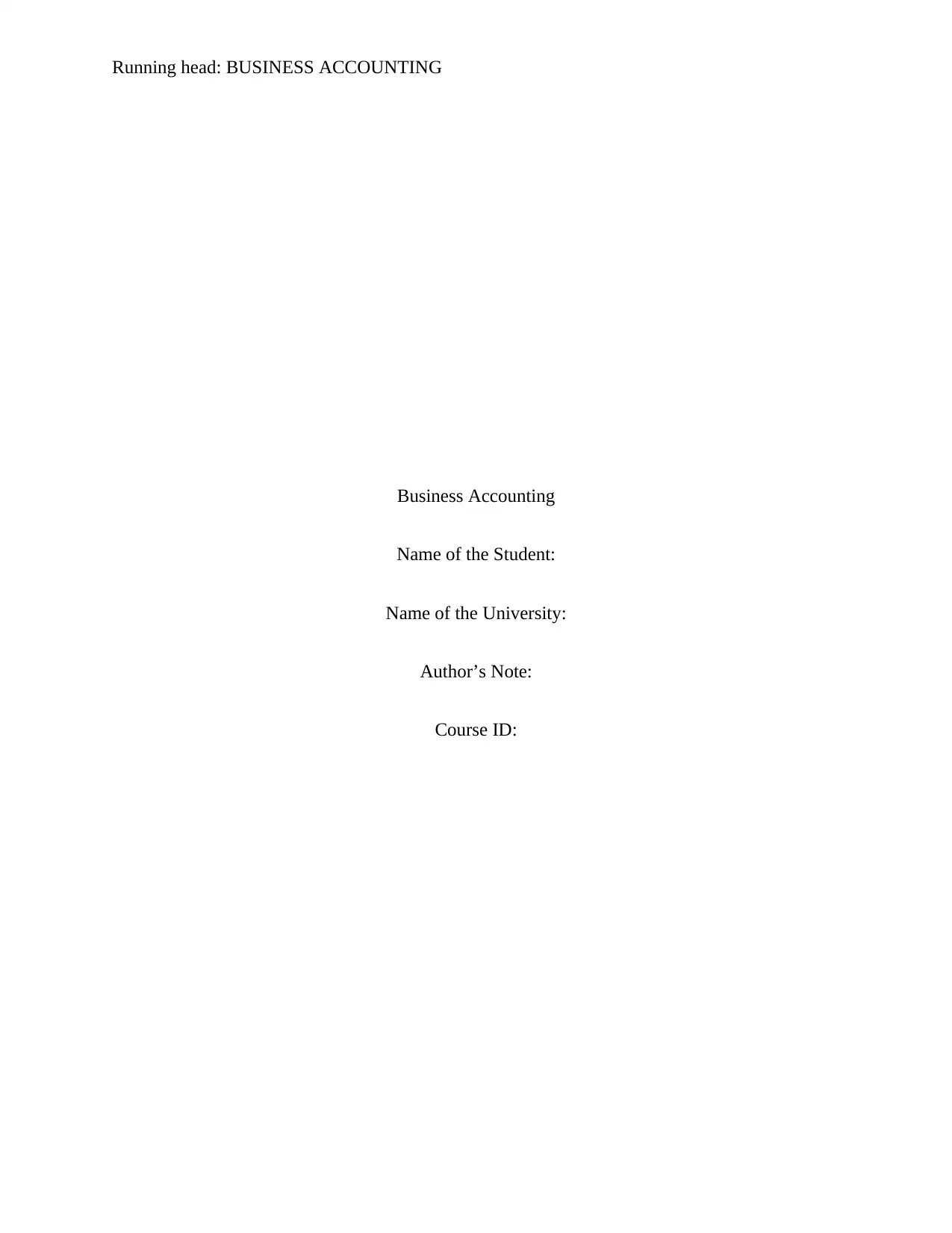
Running head: BUSINESS ACCOUNTING
Business Accounting
Name of the Student:
Name of the University:
Author’s Note:
Course ID:
Business Accounting
Name of the Student:
Name of the University:
Author’s Note:
Course ID:
Paraphrase This Document
Need a fresh take? Get an instant paraphrase of this document with our AI Paraphraser

1BUSINESS ACCOUNTING
Table of Contents
Step 7: Answering the following questions considering proper referencing...................................2
1. Identifying the trial balance and why is it created:......................................................................2
2. Stating what is adjustment journal entries, while indicating why do we record the adjustment
journal entries:.................................................................................................................................3
3. Indicating the purpose of writing an adjusted trial balance:........................................................3
4. Stating how journal entries are different from the closing journal entries:.................................4
References:......................................................................................................................................6
Table of Contents
Step 7: Answering the following questions considering proper referencing...................................2
1. Identifying the trial balance and why is it created:......................................................................2
2. Stating what is adjustment journal entries, while indicating why do we record the adjustment
journal entries:.................................................................................................................................3
3. Indicating the purpose of writing an adjusted trial balance:........................................................3
4. Stating how journal entries are different from the closing journal entries:.................................4
References:......................................................................................................................................6

2BUSINESS ACCOUNTING
Step 7: Answering the following questions considering proper referencing
1. Identifying the trial balance and why is it created:
Trial balance is an account that comprises of nominal ledger account balances, which
helps in deriving the total balance of the company. Moreover, a trial balance is considered a
statement of all credits and debits in a double entry account book. The trial balance of an
organisation comprises of all the ledger accounting that is used by the company in their
operations. Moreover, the trial balance is considered as an adequate procedure, which allows the
managers to identify the relevant loopholes and problems that occur in current debt and credit
balance of the organisation. Furthermore, trial balance provides relevant reassurance to the
double entries that have been recorded in the financial books of the organisation. Hence, trial
balance is containing the ledger accounts that have the correct sum of the day’s books.
Trial balance is prepared by the organisation to determine and check the total debt
balances with credit balance. Any disparity between the debt and credit balance of the can result
in an error that is present while preparing the ledger or journal accounts. In addition, the
preparation process of the trial balance is conducted after the ledger accounting, where all the
relevant data that has been taken in consideration in the ledger account is used. Kaplan and
Atkinson (2015) mentioned that trial balance is a bookkeeping or accounting report that lists all
the relevant balances of an organisation in one section, where the debt and credit balance need to
tally or there is an error in the accounting process.
Step 7: Answering the following questions considering proper referencing
1. Identifying the trial balance and why is it created:
Trial balance is an account that comprises of nominal ledger account balances, which
helps in deriving the total balance of the company. Moreover, a trial balance is considered a
statement of all credits and debits in a double entry account book. The trial balance of an
organisation comprises of all the ledger accounting that is used by the company in their
operations. Moreover, the trial balance is considered as an adequate procedure, which allows the
managers to identify the relevant loopholes and problems that occur in current debt and credit
balance of the organisation. Furthermore, trial balance provides relevant reassurance to the
double entries that have been recorded in the financial books of the organisation. Hence, trial
balance is containing the ledger accounts that have the correct sum of the day’s books.
Trial balance is prepared by the organisation to determine and check the total debt
balances with credit balance. Any disparity between the debt and credit balance of the can result
in an error that is present while preparing the ledger or journal accounts. In addition, the
preparation process of the trial balance is conducted after the ledger accounting, where all the
relevant data that has been taken in consideration in the ledger account is used. Kaplan and
Atkinson (2015) mentioned that trial balance is a bookkeeping or accounting report that lists all
the relevant balances of an organisation in one section, where the debt and credit balance need to
tally or there is an error in the accounting process.
⊘ This is a preview!⊘
Do you want full access?
Subscribe today to unlock all pages.

Trusted by 1+ million students worldwide
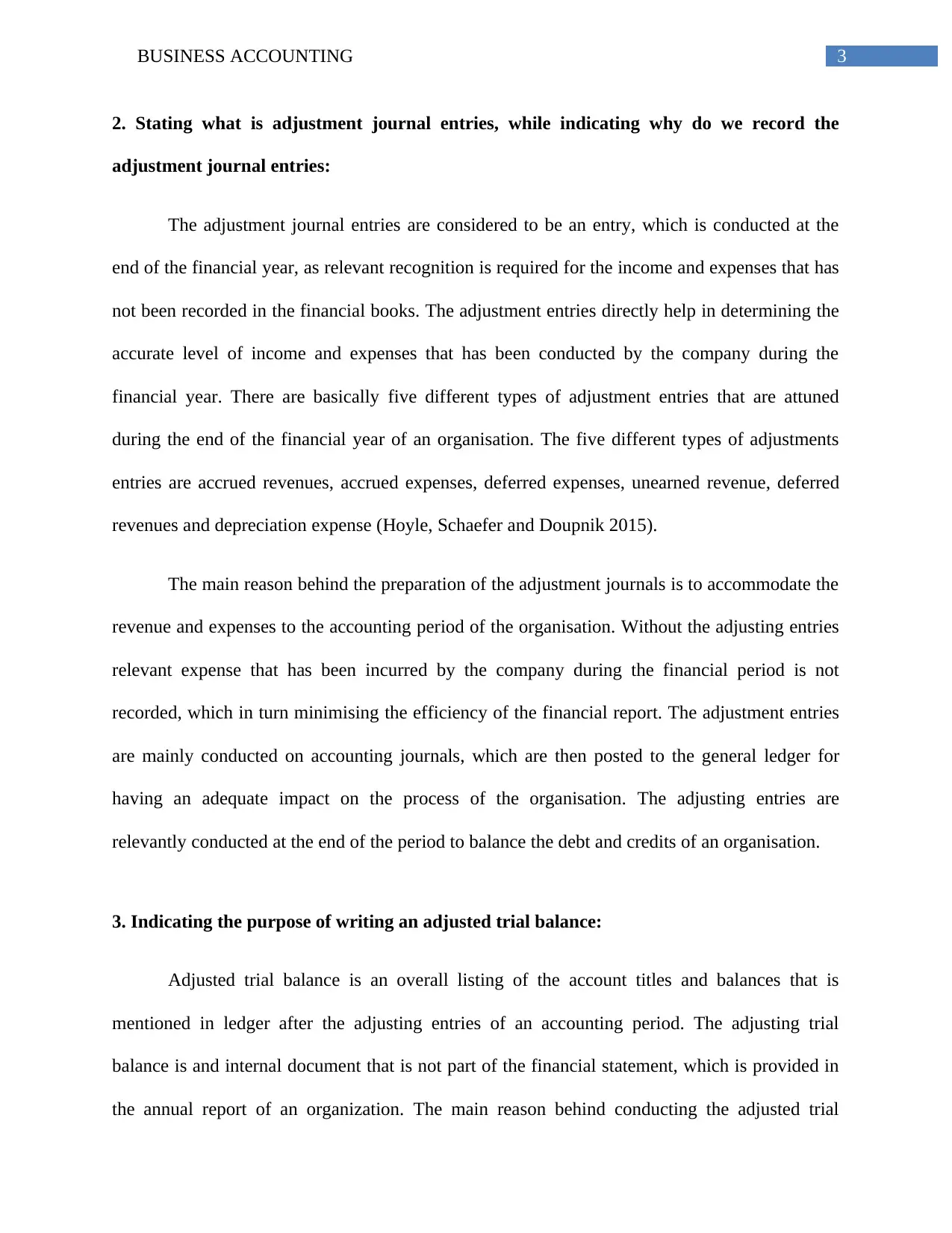
3BUSINESS ACCOUNTING
2. Stating what is adjustment journal entries, while indicating why do we record the
adjustment journal entries:
The adjustment journal entries are considered to be an entry, which is conducted at the
end of the financial year, as relevant recognition is required for the income and expenses that has
not been recorded in the financial books. The adjustment entries directly help in determining the
accurate level of income and expenses that has been conducted by the company during the
financial year. There are basically five different types of adjustment entries that are attuned
during the end of the financial year of an organisation. The five different types of adjustments
entries are accrued revenues, accrued expenses, deferred expenses, unearned revenue, deferred
revenues and depreciation expense (Hoyle, Schaefer and Doupnik 2015).
The main reason behind the preparation of the adjustment journals is to accommodate the
revenue and expenses to the accounting period of the organisation. Without the adjusting entries
relevant expense that has been incurred by the company during the financial period is not
recorded, which in turn minimising the efficiency of the financial report. The adjustment entries
are mainly conducted on accounting journals, which are then posted to the general ledger for
having an adequate impact on the process of the organisation. The adjusting entries are
relevantly conducted at the end of the period to balance the debt and credits of an organisation.
3. Indicating the purpose of writing an adjusted trial balance:
Adjusted trial balance is an overall listing of the account titles and balances that is
mentioned in ledger after the adjusting entries of an accounting period. The adjusting trial
balance is and internal document that is not part of the financial statement, which is provided in
the annual report of an organization. The main reason behind conducting the adjusted trial
2. Stating what is adjustment journal entries, while indicating why do we record the
adjustment journal entries:
The adjustment journal entries are considered to be an entry, which is conducted at the
end of the financial year, as relevant recognition is required for the income and expenses that has
not been recorded in the financial books. The adjustment entries directly help in determining the
accurate level of income and expenses that has been conducted by the company during the
financial year. There are basically five different types of adjustment entries that are attuned
during the end of the financial year of an organisation. The five different types of adjustments
entries are accrued revenues, accrued expenses, deferred expenses, unearned revenue, deferred
revenues and depreciation expense (Hoyle, Schaefer and Doupnik 2015).
The main reason behind the preparation of the adjustment journals is to accommodate the
revenue and expenses to the accounting period of the organisation. Without the adjusting entries
relevant expense that has been incurred by the company during the financial period is not
recorded, which in turn minimising the efficiency of the financial report. The adjustment entries
are mainly conducted on accounting journals, which are then posted to the general ledger for
having an adequate impact on the process of the organisation. The adjusting entries are
relevantly conducted at the end of the period to balance the debt and credits of an organisation.
3. Indicating the purpose of writing an adjusted trial balance:
Adjusted trial balance is an overall listing of the account titles and balances that is
mentioned in ledger after the adjusting entries of an accounting period. The adjusting trial
balance is and internal document that is not part of the financial statement, which is provided in
the annual report of an organization. The main reason behind conducting the adjusted trial
Paraphrase This Document
Need a fresh take? Get an instant paraphrase of this document with our AI Paraphraser
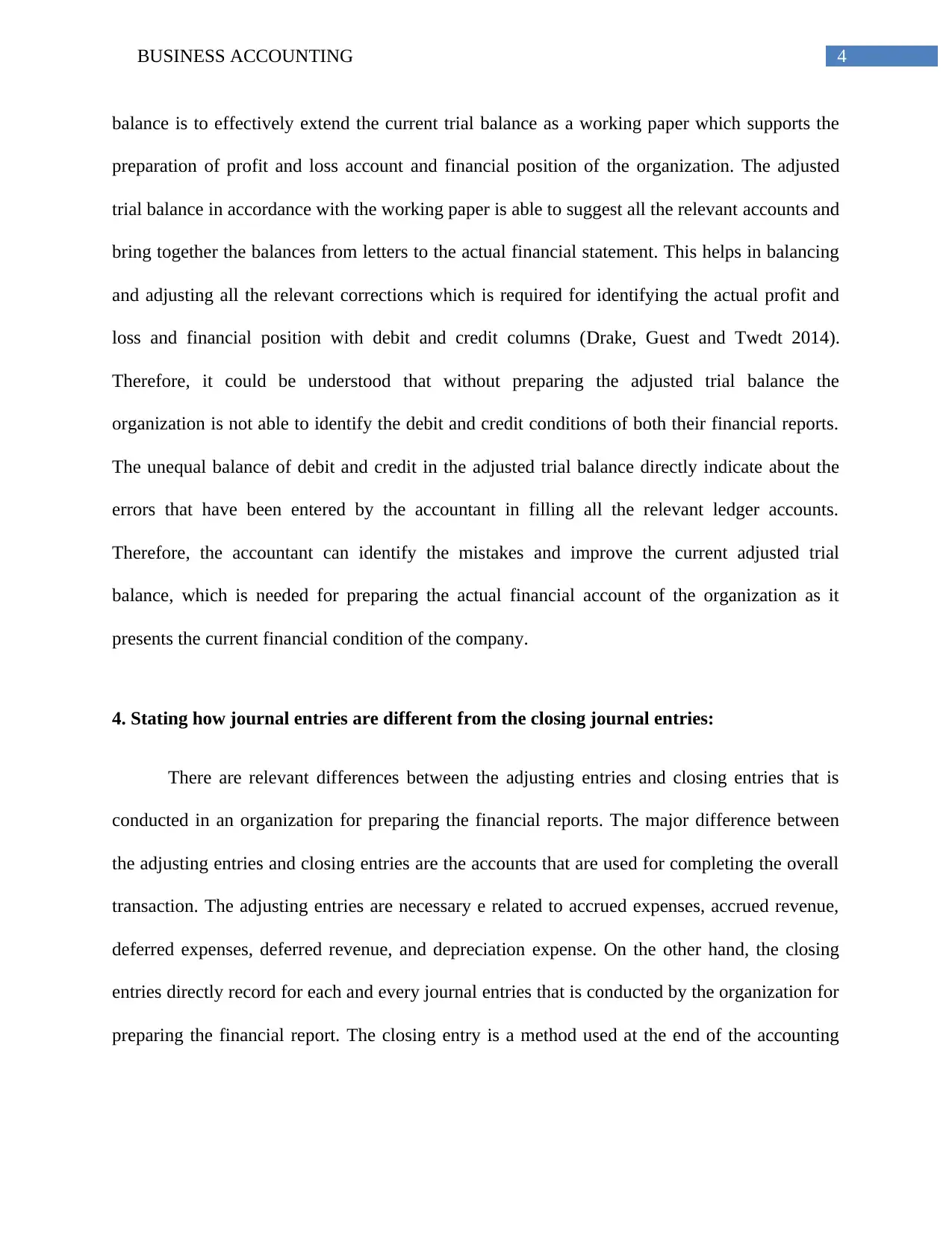
4BUSINESS ACCOUNTING
balance is to effectively extend the current trial balance as a working paper which supports the
preparation of profit and loss account and financial position of the organization. The adjusted
trial balance in accordance with the working paper is able to suggest all the relevant accounts and
bring together the balances from letters to the actual financial statement. This helps in balancing
and adjusting all the relevant corrections which is required for identifying the actual profit and
loss and financial position with debit and credit columns (Drake, Guest and Twedt 2014).
Therefore, it could be understood that without preparing the adjusted trial balance the
organization is not able to identify the debit and credit conditions of both their financial reports.
The unequal balance of debit and credit in the adjusted trial balance directly indicate about the
errors that have been entered by the accountant in filling all the relevant ledger accounts.
Therefore, the accountant can identify the mistakes and improve the current adjusted trial
balance, which is needed for preparing the actual financial account of the organization as it
presents the current financial condition of the company.
4. Stating how journal entries are different from the closing journal entries:
There are relevant differences between the adjusting entries and closing entries that is
conducted in an organization for preparing the financial reports. The major difference between
the adjusting entries and closing entries are the accounts that are used for completing the overall
transaction. The adjusting entries are necessary e related to accrued expenses, accrued revenue,
deferred expenses, deferred revenue, and depreciation expense. On the other hand, the closing
entries directly record for each and every journal entries that is conducted by the organization for
preparing the financial report. The closing entry is a method used at the end of the accounting
balance is to effectively extend the current trial balance as a working paper which supports the
preparation of profit and loss account and financial position of the organization. The adjusted
trial balance in accordance with the working paper is able to suggest all the relevant accounts and
bring together the balances from letters to the actual financial statement. This helps in balancing
and adjusting all the relevant corrections which is required for identifying the actual profit and
loss and financial position with debit and credit columns (Drake, Guest and Twedt 2014).
Therefore, it could be understood that without preparing the adjusted trial balance the
organization is not able to identify the debit and credit conditions of both their financial reports.
The unequal balance of debit and credit in the adjusted trial balance directly indicate about the
errors that have been entered by the accountant in filling all the relevant ledger accounts.
Therefore, the accountant can identify the mistakes and improve the current adjusted trial
balance, which is needed for preparing the actual financial account of the organization as it
presents the current financial condition of the company.
4. Stating how journal entries are different from the closing journal entries:
There are relevant differences between the adjusting entries and closing entries that is
conducted in an organization for preparing the financial reports. The major difference between
the adjusting entries and closing entries are the accounts that are used for completing the overall
transaction. The adjusting entries are necessary e related to accrued expenses, accrued revenue,
deferred expenses, deferred revenue, and depreciation expense. On the other hand, the closing
entries directly record for each and every journal entries that is conducted by the organization for
preparing the financial report. The closing entry is a method used at the end of the accounting
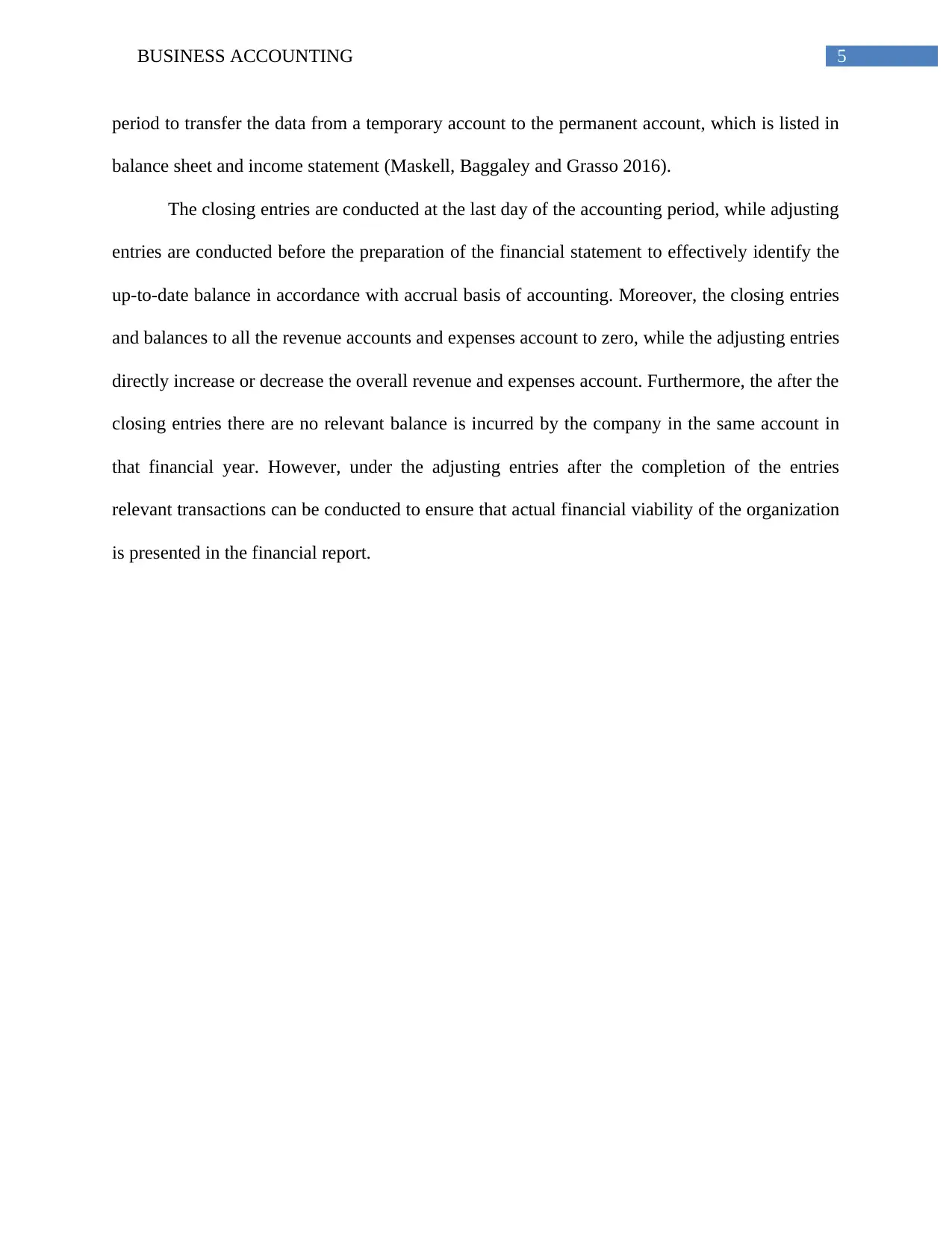
5BUSINESS ACCOUNTING
period to transfer the data from a temporary account to the permanent account, which is listed in
balance sheet and income statement (Maskell, Baggaley and Grasso 2016).
The closing entries are conducted at the last day of the accounting period, while adjusting
entries are conducted before the preparation of the financial statement to effectively identify the
up-to-date balance in accordance with accrual basis of accounting. Moreover, the closing entries
and balances to all the revenue accounts and expenses account to zero, while the adjusting entries
directly increase or decrease the overall revenue and expenses account. Furthermore, the after the
closing entries there are no relevant balance is incurred by the company in the same account in
that financial year. However, under the adjusting entries after the completion of the entries
relevant transactions can be conducted to ensure that actual financial viability of the organization
is presented in the financial report.
period to transfer the data from a temporary account to the permanent account, which is listed in
balance sheet and income statement (Maskell, Baggaley and Grasso 2016).
The closing entries are conducted at the last day of the accounting period, while adjusting
entries are conducted before the preparation of the financial statement to effectively identify the
up-to-date balance in accordance with accrual basis of accounting. Moreover, the closing entries
and balances to all the revenue accounts and expenses account to zero, while the adjusting entries
directly increase or decrease the overall revenue and expenses account. Furthermore, the after the
closing entries there are no relevant balance is incurred by the company in the same account in
that financial year. However, under the adjusting entries after the completion of the entries
relevant transactions can be conducted to ensure that actual financial viability of the organization
is presented in the financial report.
⊘ This is a preview!⊘
Do you want full access?
Subscribe today to unlock all pages.

Trusted by 1+ million students worldwide
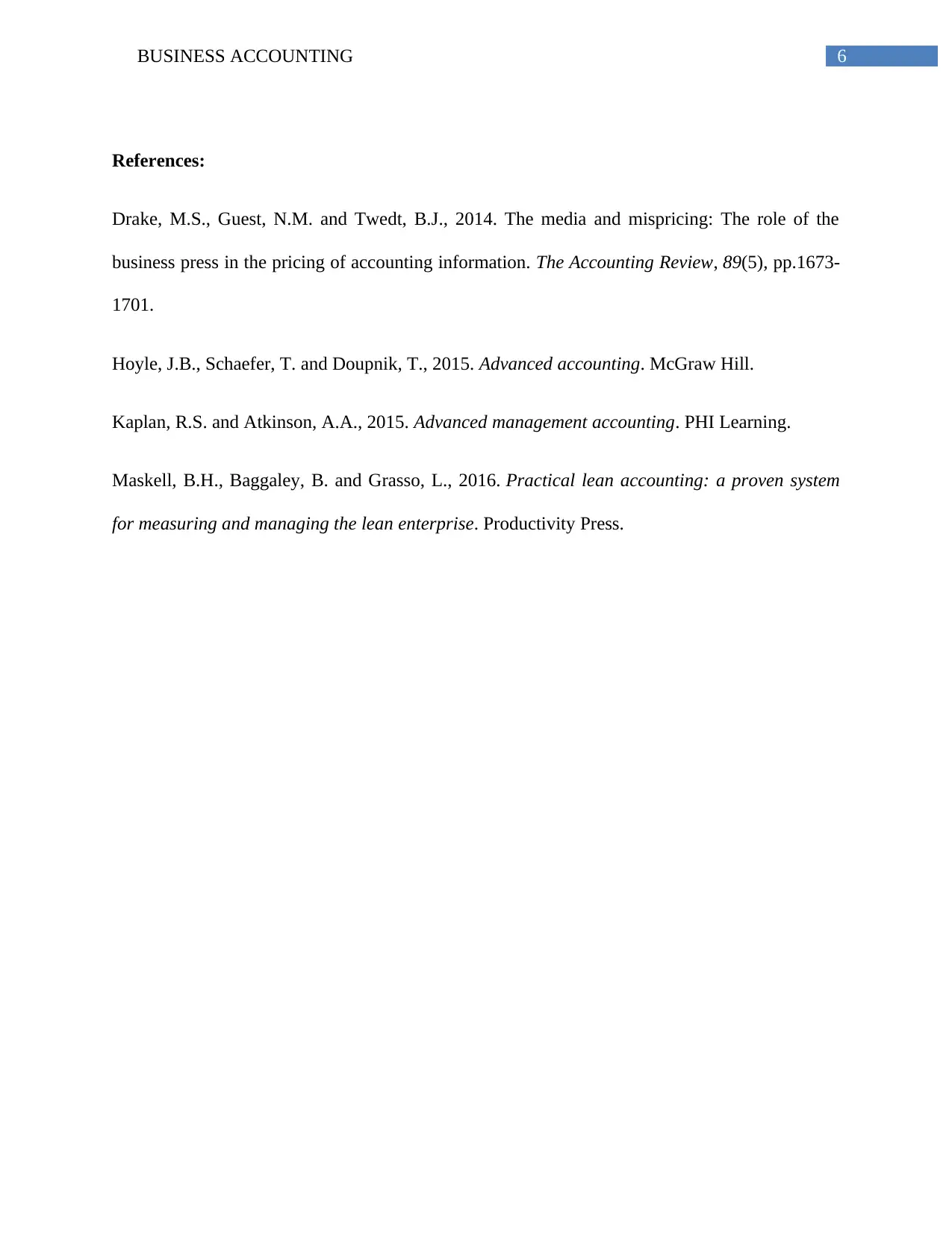
6BUSINESS ACCOUNTING
References:
Drake, M.S., Guest, N.M. and Twedt, B.J., 2014. The media and mispricing: The role of the
business press in the pricing of accounting information. The Accounting Review, 89(5), pp.1673-
1701.
Hoyle, J.B., Schaefer, T. and Doupnik, T., 2015. Advanced accounting. McGraw Hill.
Kaplan, R.S. and Atkinson, A.A., 2015. Advanced management accounting. PHI Learning.
Maskell, B.H., Baggaley, B. and Grasso, L., 2016. Practical lean accounting: a proven system
for measuring and managing the lean enterprise. Productivity Press.
References:
Drake, M.S., Guest, N.M. and Twedt, B.J., 2014. The media and mispricing: The role of the
business press in the pricing of accounting information. The Accounting Review, 89(5), pp.1673-
1701.
Hoyle, J.B., Schaefer, T. and Doupnik, T., 2015. Advanced accounting. McGraw Hill.
Kaplan, R.S. and Atkinson, A.A., 2015. Advanced management accounting. PHI Learning.
Maskell, B.H., Baggaley, B. and Grasso, L., 2016. Practical lean accounting: a proven system
for measuring and managing the lean enterprise. Productivity Press.
1 out of 7
Related Documents
Your All-in-One AI-Powered Toolkit for Academic Success.
+13062052269
info@desklib.com
Available 24*7 on WhatsApp / Email
![[object Object]](/_next/static/media/star-bottom.7253800d.svg)
Unlock your academic potential
Copyright © 2020–2025 A2Z Services. All Rights Reserved. Developed and managed by ZUCOL.




